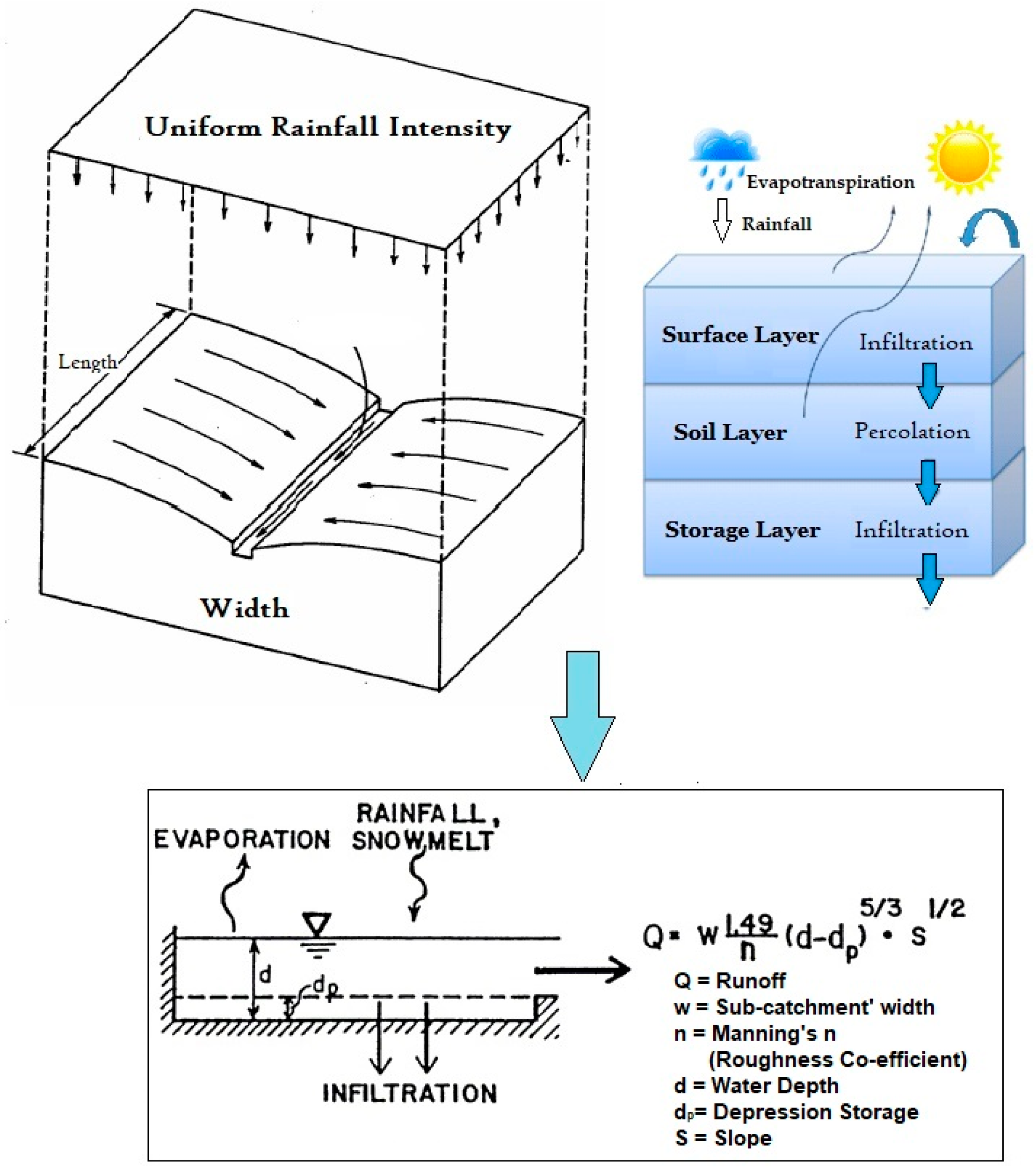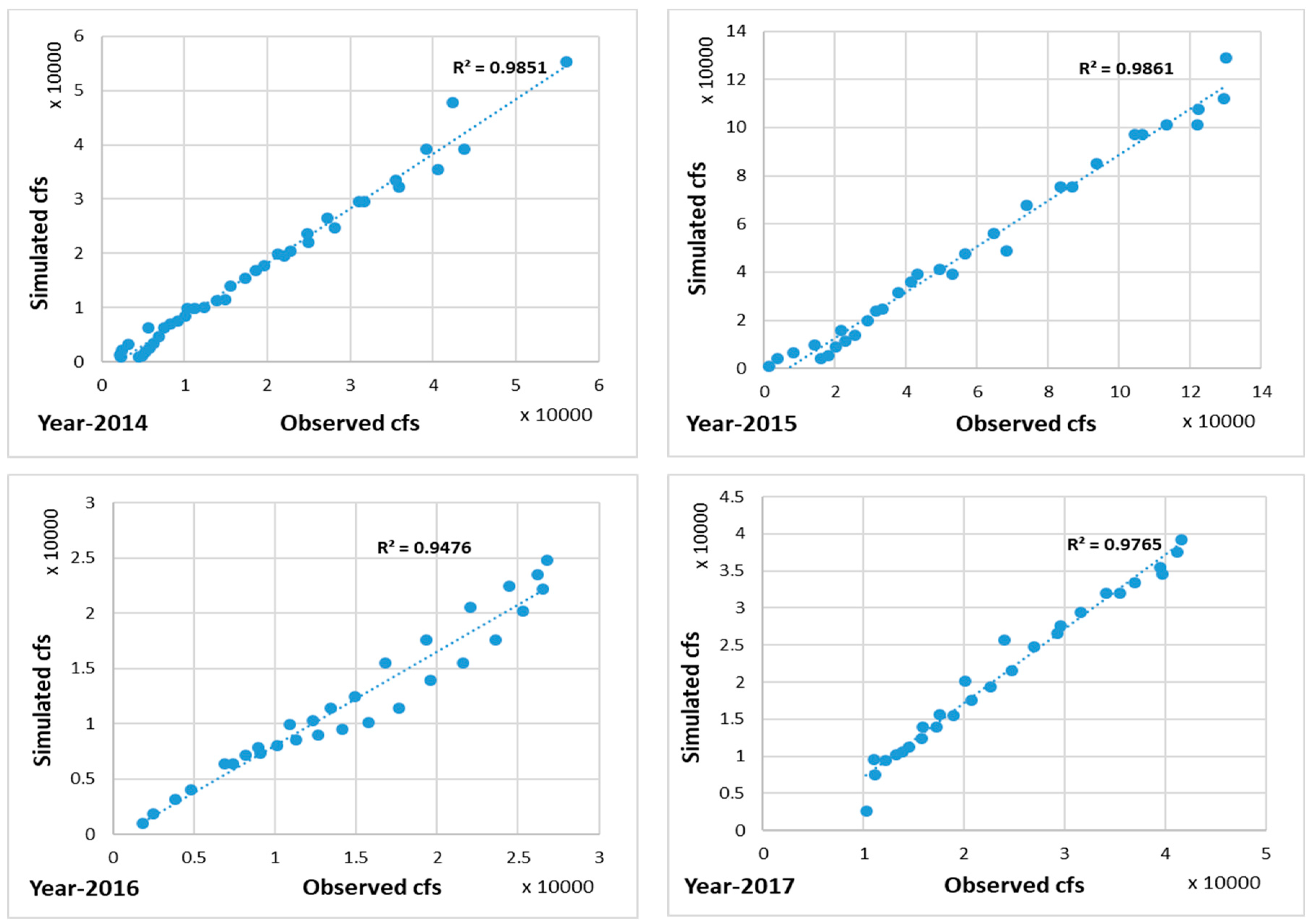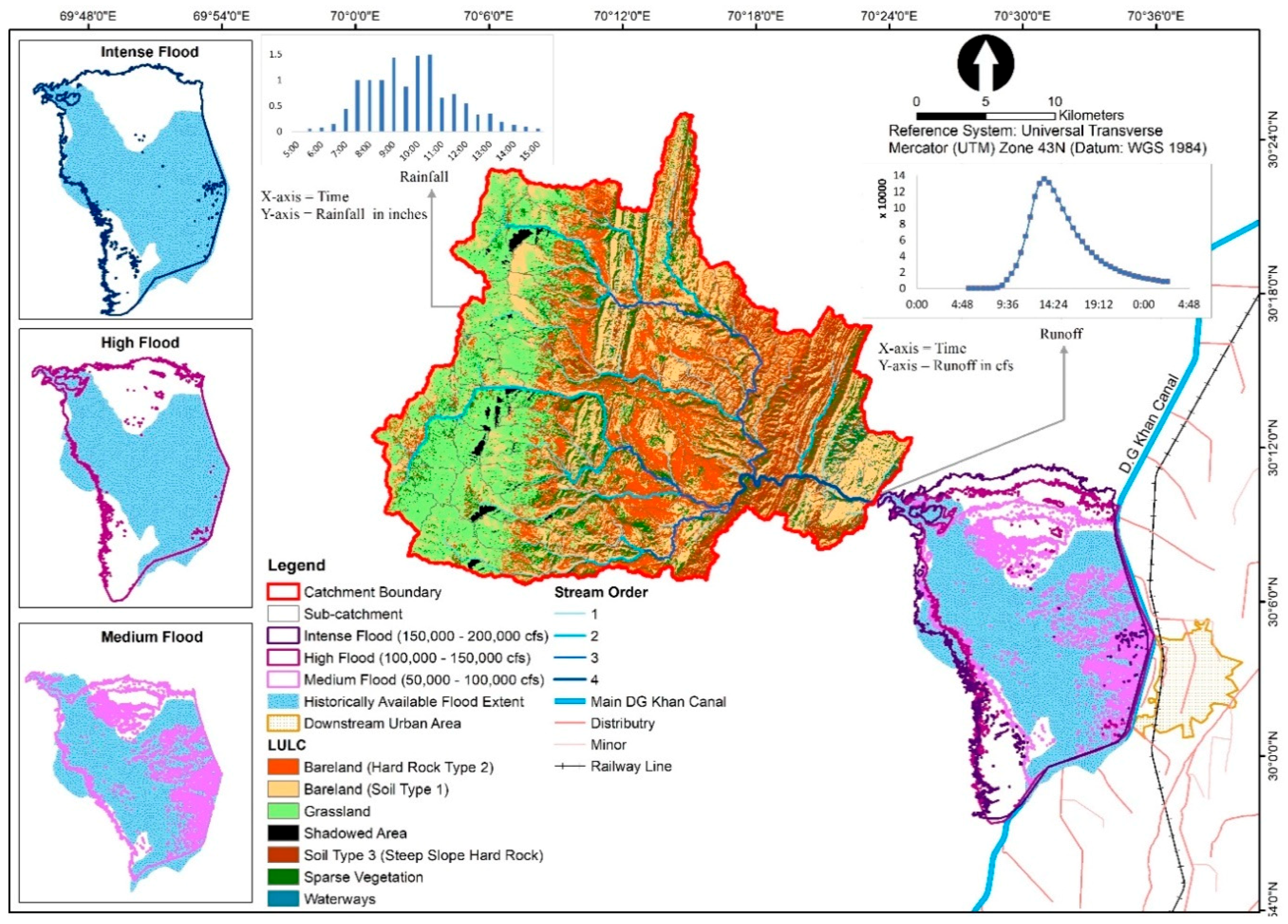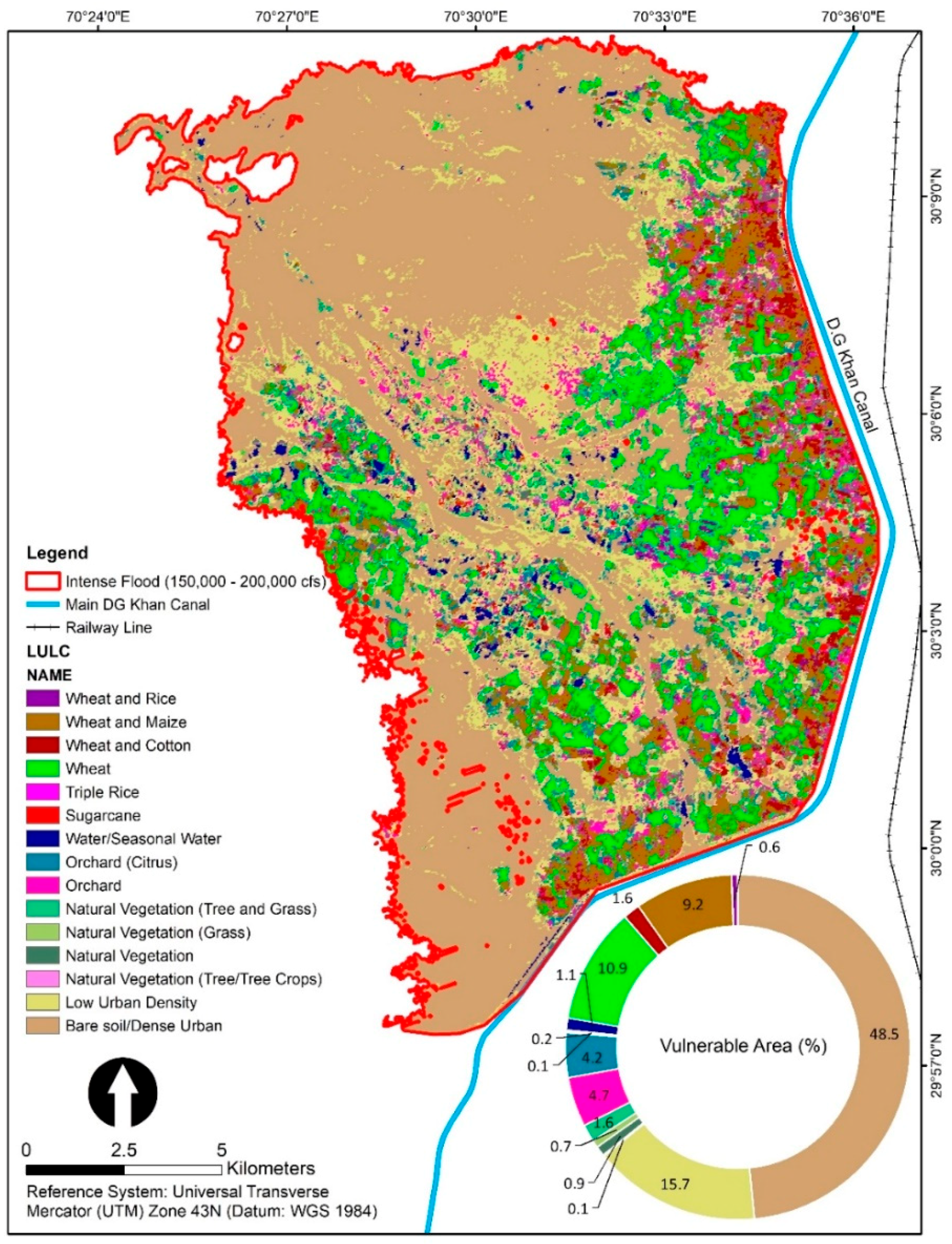Integrated Hazard Modeling for Simulating Torrential Stream Response to Flash Flood Events
Abstract
:1. Introduction
2. Materials and Methods
2.1. Study Area
2.2. Models Description
2.3. Data and Processing
2.4. PCSWMM Input Parameter Estimation
2.5. Calibration and Validation
2.6. Flash Flood Exposure Assessment
3. Results
3.1. Measured and Inferred Parameters
3.2. PCSWMM Simulations
3.3. Data Limitations and Interpolation
3.4. Flood Extent Analysis (2D Simulations)
3.5. Flash Flood Exposure and LULC Vulnerability
4. Discussion
5. Conclusions
- Slope adjusted CN scheme at sub-catchment level accurately quantifies the peak events for Vidor torrent and proved the applicability of the adopted procedure for torrented areas. The statistical indicators (NSE, R2, RE) justifies the result with high values (0.75–0.97, 0.94–0.98, and −0.22– −0.09) respectively. The semi-distributed hydrologic modeling approach using satellite rainfall-GPM in PCSWMM best fits the quantification of peak flash flood events in rural catchments with no rain gauge installed. However, the accuracy may drop for low-intensity events.
- The results substantiate the accuracy of 2D hydraulic modeling when compared, 76%, with existing flash flood extents. The areas with maximum inundation depths were observed in an exact match with the existing data collected from field staff of the Irrigation department, Pakistan.
- The visual representation of inundation depths and flood extents based on 0.5/12.7, 1.5/ 38.1, and 2.0/50.8 inch/mm rainfall and flash flood event of the year 2015 (intense flash flood event observed in past years) were analyzed to evaluate the behavior of flash flood water in the piedmont plain. Recursive 2D hydraulic simulations identify the areas with maximum inundation. The maximum depth was observed near the vague footprints of natural nullah.
- The overlay analogy of GIS and RS schemes were used for vulnerability analysis against intense flash flood extent. Patchy rural settlements and wheat crop in the piedmont areas were observed most vulnerable for generated flash flood scenarios. The overlay scheme is proved handy for vulnerability and risk analysis for data-poor areas.
- The methodology and substantiated results confirmed the application of PCSWMM with advance SRTC calibration module and 2D hydraulic simulation of HEC-RAS in chorological (space-wise) and chronological (time-wise) domains. However, the research upshot suggests that real-time discharge observations should be carried out at hourly basis to better check the accuracy of PCSWMM. The flash flood extents were demarcated using 12.5 m ALOS-PALSAR open-source DEM; however, the extents may be improved using high resolution DEM.
6. Recommendations
Author Contributions
Funding
Acknowledgments
Conflicts of Interest
References
- Van Westen, C.J.; Alkema, D.; Damen, M.C.J.; Kerle, N.; Kingma, N.C. Multi-Hazard Risk Assessment: Distance Education Course Guide Book; United Nations University—ITC School on Disaster Geoinformation Management: Tokyo, Japan, 2009. [Google Scholar]
- Norbiato, D.; Borga, M.; Degli Esposti, S.; Gaume, E.; Anquetin, S. Flash flood warning based on rainfall thresholds and soil moisture conditions: An assessment for gauged and ungauged basins. J. Hydrol. 2008, 362, 274–290. [Google Scholar] [CrossRef]
- Gaume, E.; Bain, V.; Bernardara, P.; Newinger, O.; Barbuc, M.; Bateman, A.; Blaškoviĉová, L.; Blöschl, G.; Borga, M.; Dumitrescu, A.; et al. A compilation of data on European flash floods. J. Hydrol. 2009, 367, 70–78. [Google Scholar] [CrossRef] [Green Version]
- Liste, M.; Grifoll, M.; Monbaliu, J. River plume dispersion in response to flash flood events. Application to the Catalan shelf. Cont. Shelf Res. 2014, 87, 96–108. [Google Scholar] [CrossRef]
- Borga, M.; Boscolo, P.; Zanon, F.; Sangati, M. Hydrometeorological analysis of the 29 August 2003 flash flood in the eastern Italian Alps. J. Hydrometeorol. 2007, 8, 1049–1067. [Google Scholar] [CrossRef]
- Xiaotao, L.; Shifeng, H.; Tao, S.; Jinfeng, X. Design and Implementation of Flood Monitoring and Assessment System. In Proceedings of the 2011 International Symposium on Image and Data Fusion (ISIDF), Tengchong, China, 9–11 August 2011; pp. 1–3. [Google Scholar]
- Munir, B.A.; Iqbal, J. Flash flood water management practices in Dera Ghazi Khan City (Pakistan): A remote sensing and GIS prospective. Nat. Hazards 2016, 81, 1303–1321. [Google Scholar] [CrossRef]
- Petrovic, A. Challenges of torrential flood risk management in Serbia. J. Geogr. Inst. Jovan Cvijic SASA 2015, 65, 131–143. [Google Scholar] [CrossRef]
- Fan, F.; Deng, Y.; Hu, X.; Weng, Q. Estimating Composite Curve Number Using an Improved SCS-CN Method with Remotely Sensed Variables in. Remote. Sens. 2013, 5, 1425–1438. [Google Scholar] [CrossRef] [Green Version]
- Moynihan, K.P.; Vasconcelos, J.G. SWMM Modelling of a Rural Watershed in the Lower Coastal Plains of the United States. J. Water Manag. Model. 2014, 1–12. [Google Scholar] [CrossRef] [Green Version]
- Nielsen, S.A.; Hansen, E. Numerical simulation of the rainfall runoff process on a daily basis. Nord. Hydrol. Res. 1973, 4, 171–190. [Google Scholar] [CrossRef]
- Burnash, R.J.C. The NWS river forecast system-catchment modelling. Comput. Models Watershed Hydrol. 1995, 188, 311–366. [Google Scholar]
- Wang, W.; Shao, Q.; Yang, T.; Peng, S.; Xing, W.; Sun, F.; Luo, Y. Quantitative assessment of the impact of climate variability and human activities on runoff changes: A case study in four catchments of the Haihe River basin, China. Hydrol. Process. 2013, 27, 1158–1174. [Google Scholar] [CrossRef]
- Jiang, C.; Xiong, L.; Wang, D.; Liu, P.; Guo, S.; Xu, C.Y. Separating the impacts of climate change and human activities on runoff using the Budyko-type equations with time-varying parameters. J. Hydrol. 2015, 522, 326–338. [Google Scholar] [CrossRef]
- Gutiérrez, F.; Parise, M.; De Waele, J.; Jourde, H. A review on natural and human-induced geohazards and impacts in karst. Earth Sci. Rev. 2014, 138, 61–88. [Google Scholar] [CrossRef]
- Ahmad, I.; Verma, V.; Verma, M.K. Application of Curve Number Method for Estimation of Runoff Potential in GIS Environment. In Proceedings of the 2015 2nd International Conference on Geological and Civil Engineering (ICGCE), Singapore, 10–11 January 2015; Volume 80, pp. 16–20. [Google Scholar] [CrossRef]
- Zoccatelli, D.; Borga, M.; Viglione, A.; Chirico, G.B.; Schl, G.B. Spatial moments of catchment rainfall: Rainfall spatial organisation, Catchment morphology, and flood response. Hydrol. Earth Syst. Sci. Discuss 2011, 8, 5811–5847. [Google Scholar] [CrossRef]
- Anquetin, G.; Horgan, G.; Rawe, S.; Murray, D.; Madden, A.; Macmathuna, P.; Doran, P.; Murphy, P.V. Synthesis of novel macrolactam and macroketone analogues of migrastatin from d-glucal and comparison with macrolactone and acyclic analogues: A dorrigocin a congener is a potent inhibitor of gastric cancer cell migration. Eur. J. Org. Chem. 2008, 2008, 1953–1958. [Google Scholar] [CrossRef]
- Jia, P.; Liu, R.; Ma, M.; Liu, Q.; Wang, Y.; Zhai, X.; Xu, S.; Wang, D. Flash Flood Simulation for Ungauged Catchments Based on the Distributed Hydrological Model. Water 2019, 11, 76. [Google Scholar] [CrossRef] [Green Version]
- El-Nasr, A.A.; Arnold, J.G.; Feyen, J.; Berlamont, J. Modelling the hydrology of a catchment using a distributed and a semi-distributed model. Hydrol. Process. 2005, 19, 573–587. [Google Scholar] [CrossRef]
- Reed, S.; Schaake, J.; Zhang, Z. A distributed hydrologic model and threshold frequency-based method for flash flood forecasting at ungauged locations. J. Hydrol. 2007, 337, 402–420. [Google Scholar] [CrossRef]
- Walega, A.; Cupak, A.; Amatya, D.M.; Drozdzal, E. Comparison of direct outflow calculated by modified SCS-CN methods for mountainous and highland catchments in upper Vistula Basin, Poland and lowland catchment in South Carolina, U.S.A. Acta Sci. Pol. Form. Circumiectus 2017, 16, 187–207. [Google Scholar] [CrossRef]
- Gironas, J. Morphologic Characterization of Urban Watersheds and Its Use in Quantifying Hydrologic Response; Dissertations Theses-Gradworks; Colorado State University: Fort Collins, CO, USA, 2009. [Google Scholar]
- Khaleghi, M.R.; Gholami, V.; Ghodusi, J.; Hosseini, H. Efficiency of the geomorphologic instantaneous unit hydrograph method in flood hydrograph simulation. Catena 2011, 87, 163–171. [Google Scholar] [CrossRef]
- Beven, K.; Freer, J. Equifinality, data assimilation, and uncertainty estimation in mechanistic modelling of complex environmental systems using the GLUE methodology. J. Hydrol. 2001, 249, 11–29. [Google Scholar] [CrossRef]
- Silberstein, R.P. Hydrological models are so good; do we still need data? Environ. Model. Softw. 2006, 21, 1340–1352. [Google Scholar] [CrossRef]
- Xie, J.; Chen, H.; Liao, Z.; Gu, X.; Zhu, D.; Zhang, J. An integrated assessment of urban flooding mitigation strategies for robust decision making. Environ. Model. Softw. 2017, 95, 143–155. [Google Scholar] [CrossRef]
- Hu, W.; He, W.; Huang, G.; Feng, J. Review of urban storm water simulation techniques. Adv. Water Sci. 2010, 21, 137–144. (In Chinese) [Google Scholar]
- Wu, X.; Wang, Z.; Guo, S.; Liao, W.; Zeng, Z.; Chen, X. Scenario-based projections of future urban inundation within a coupled hydrodynamic model framework: A case study in Dongguan City, China. J. Hydrol. 2017, 547, 428–442. [Google Scholar] [CrossRef]
- Huang, Q.; Wang, J.; Li, M.; Fei, M.; Dong, J. Modelling the influence of urbanization on urban pluvial flooding: A scenario-based case study in Shanghai, China. Nat. Hazards 2017, 87, 1035–1055. [Google Scholar] [CrossRef]
- Cheng, T.; Xu, Z.; Hong, S.; Song, S. Flood risk zoning by using 2D hydrodynamic modelling: A case study in Jinan City. Math. Probl. Eng. 2017. [Google Scholar] [CrossRef] [Green Version]
- Tavakol-Davani, H.; Burian, S.; Apul, D.; Devkota, J. Developing urban water infrastructure modelling approach to control flood damages and reduce life cycle impacts. In Proceedings of the World Environmental and Water Resources Congress 2013: Showcasing Future, Cincinnati, OH, USA, 19–23 May 2013; pp. 2951–2958. [Google Scholar]
- Avila, H.; Avila, L.; Sisa, A. Dispersed storage as stormwater runoff control in consolidated urban watersheds with flash flood risk. J. Water Resour. Plan. Manag. 2016, 142, 04016056. [Google Scholar] [CrossRef]
- Avila, L.; Ávila, H.; Sisa, A. A Reactive Early Warning Model for Urban Flash Flood Management. In Proceedings of the World Environmental and Water Resources Congress, Sacramento, CA, USA, 21–25 May 2017; pp. 372–382. [Google Scholar]
- Huber, W.; Heaney, J.; Medina, M.; Peltz, W.; Sheikh, H. Storm Water Management Model: User’s Manual, 2nd ed.; 1975. [Google Scholar]
- Gironás, J.; Roesner, L.A.; Rossman, L.A.; Davis, J. A new applications manual for the Storm Water Management Model (SWMM). Environ. Model. Software 2010, 25, 813–814. [Google Scholar]
- Tariq, M.A.U.R. Risk-based flood zoning employing expected annual damages: The Chenab River case study. Stoch. Environ. Res. Risk Assess. 2013, 27, 1957–1966. [Google Scholar] [CrossRef]
- Saher, F.N.; Nasly, M.A.; Kadir, T.A.B.A.; Yahaya, N.K.E.; Ishak, W.M.F.W. Harnessing floodwater of hill torrents for improved spate irrigation system using geo-informatics approach. Res. J. Recent Sci. 2014, 3, 14–22. [Google Scholar]
- Hanif, M.; Khan, A.H.; Adnan, S. Latitudinal precipitation characteristics and trends in Pakistan. J. Hydrol. 2013, 492, 266–272. [Google Scholar] [CrossRef]
- Tariq, M.A.U.R.; Van de Giesen, N. Floods and flood management in Pakistan. Phys. Chem. Earth Parts A/B/C 2012, 47, 11–20. [Google Scholar] [CrossRef]
- Ahmad, M. Famer’s Irrigation Practices under Rod Kohi Irrigation System, Department of Irrigation and Drainage, Faculty of Agricultural Engineering and Technology; University of Agriculture: Faisalabad, Pakistan, 2003. [Google Scholar]
- Ahmad, M. Optimal Management of Water Resources in Selected Hill Torrent Command Area of University of Agriculture: Faisalabad, Pakistan. 2016. Available online: http://prr.hec.gov.pk/jspui/bitstream/123456789/7941/1/Matlob Ahmad Full.pdf (accessed on 10 December 2019).
- Leong, T.M.; Ibrahim, A.L.B. Remote sensing, geographic information system and hydrological model for rainfall-runoff modelling. In 33rd Asian Conference on Remote Sensing 2012, ACRS 2012; 2012; Volume 2, pp. 1334–1343. Available online: http://www.scopus.com/inward/record.url?eid=2-s2.0-84880019131&partnerID=tZOtx3y1 (accessed on 10 December 2019).
- Luan, Q.; Fu, X.; Song, C.; Wang, H.; Liu, J.; Wang, Y. Runoff Effect Evaluation of LID through SWMM in Typical Mountainous, Low-Lying Urban Areas: A Case Study in China. Water 2017, 9, 439. [Google Scholar] [CrossRef] [Green Version]
- Rees, P.; Schoen, J. PCSWMM Evaluation: Project# 08-08/319: Final Technical Report; University of Massachusetts: Amherst, MA, USA; Water Resources Research Center: Tucson, AZ, USA, 2009. [Google Scholar]
- Cronshey, R. Urban Hydrology for Small Watersheds-Technical Release 55, 2nd ed.; Dept. of Agriculture, Soil Conservation Service, Engineering Division: Washington, DC, USA, 1986.
- Jain, G.V.; Agrawal, R.; Bhanderi, R.J.; Jayaprasad, P.; Patel, J.N.; Agnihotri, P.G.; Samtani, B.M. Estimation of sub-catchment area parameters for Storm Water Management Model (SWMM) using geo-informatics. Geocarto Int. 2015, 31, 462–476. [Google Scholar] [CrossRef]
- Ebrahimian, M.; Nuruddin, A.A.B.; Amin, M.; Soom, B.M.; Sood, A.M.; Neng, L.J. Runoff Estimation in Steep Slope Watershed with Standard and Slope-Adjusted Curve Number Methods. Pol. J. Environ. Stud. 2012, 21, 1191–1202. [Google Scholar]
- James, W. Rules for Responsible Modelling; Computational Hydraulics International (CHI): Guelph, ON, Canada, 2005. [Google Scholar]
- Huber, W.C.; Dickinson, W.T. Storm Water Management Model; Version 4; User’s Manual, USEPA. EPA-600-3-88-001a: Athens, Georgia, 1992. [Google Scholar]
- Rossman, L.A. Storm Water Management Model User’s Manual; version 5.0; National Risk Management Research Laboratory, Office of Research and Development: Cincinnati, OH, USA; US Environmental Protection Agency: Washington, DC, USA, 2010; p. 276.
- Rai, P.K.; Chahar, B.R.; Dhanya, C.T. GIS-based SWMM model for simulating the catchment response to flood events. Hydrol. Res. 2016, 48, 384–394. [Google Scholar] [CrossRef]
- EI Alfy, M. Assessing the impact of arid area urbanization on flash fl oods using GIS, remote sensing, and HEC-HMS rainfall—Runoff modelling Mohamed El Alfy. Hydrol. Res. 2016, 47, 1142–1160. [Google Scholar] [CrossRef]
- Santhi, C.; Arnold, J.G.; Williams, J.R.; Dugas, W.A.; Srinivasan, R.; Hauck, L.M. Validation of the swat model on a large RWER basin with point and nonpoint sources. J. Am. Water Resour. Assoc. 2001, 37, 1169–1188. [Google Scholar] [CrossRef]
- Saleh, A.; Arnold, J.G.; Gassman, P.W.A.; Hauck, L.M.; Rosenthal, W.D.; Williams, J.R.; McFarland, A.M.S. Application of SWAT for the upper North Bosque River watershed. Trans. ASAE 2000, 43, 1077–1087. [Google Scholar] [CrossRef]
- Akhter, M.; Hewa, G. The Use of PCSWMM for Assessing the Impacts of Land Use Changes on Hydrological Responses and Performance of WSUD in Managing the Impacts at Myponga Catchment, South Australia. Water 2016, 8, 511. [Google Scholar] [CrossRef]
- Hossain, F.; Katiyar, N. Improving flood forecasting in international river basins. Eos Trans. Am. Geophys. Union 2006, 87, 49–54. [Google Scholar] [CrossRef] [Green Version]
- Ghosh, S.; Nandy, S.; Kumar, S. Rapid assessment of recent flood episode in Kaziranga National Park, Assam using remotely sensed satellite data. Curr. Sci. 2016, 111, 1450–1451. [Google Scholar]
- Yuan, F.; Zhang, L.; Win, K.; Ren, L.; Zhao, C.; Zhu, Y.; Liu, Y. Assessment of GPM and TRMM multi-satellite precipitation products in streamflow simulations in a data-sparse mountainous watershed in Myanmar. Remote. Sens. 2017, 9, 302. [Google Scholar] [CrossRef] [Green Version]
- Hou, H.; Andrews, H. Cubic splines for image interpolation and digital filtering. IEEE Trans. Acoust. Speech Signal Process. 1978, 26, 508–517. [Google Scholar]
- Sibetheros, I.A.; Holley, E.R.; Branski, J.M. Spline interpolations for water hammer analysis. J. Hydraul. Eng. 1991, 117, 1332–1351. [Google Scholar] [CrossRef]
- Kastanek, F.J.; Nielsen, D.R. Description of soil water characteristics using cubic spline interpolation. Soil Sci. Soc. Am. J. 2001, 65, 279–283. [Google Scholar] [CrossRef] [Green Version]
- Saber, N.R.; Gosman, A.D.; Wood, N.B.; Kilner, P.J.; Charrier, C.L.; Firmin, D.N. Computational flow modelling of the left ventricle based on in vivo MRI data: Initial experience. Ann. Biomed. Eng. 2001, 29, 275–283. [Google Scholar] [CrossRef]
- Daliakopoulos, I.N.; Coulibaly, P.; Tsanis, I.K. Groundwater level forecasting using artificial neural networks. J. Hydrol. 2005, 309, 229–240. [Google Scholar] [CrossRef]
- Plaia, A.; Bondi, A.L. Single imputation method of missing values in environmental pollution data sets. Atmos. Environ. 2006, 40, 7316–7330. [Google Scholar] [CrossRef]
- Fritsch, F.N.; Carlson, R.E. Monotone piecewise cubic interpolation. SIAM J. Numer. Anal. 1980, 17, 238–246. [Google Scholar] [CrossRef]
- Akbari, A. Slope Adjustment of Runoff Curve Number (CN) Using Advanced Spaceborne Thermal Emission and Reflection Radiometer (ASTER) Global Digital Elevation Model (GDEM) for Kuantan River Basin; 2015; Volume 9644, p. 96441W. [Google Scholar] [CrossRef] [Green Version]
- Gabellani, S.; Silvestro, F.; Rudari, R.; Boni, G.; Magliotto, A. General calibration methodology for a combined Horton-SCS infiltration scheme in flash flood modelling. Nat. Hazards Earth Syst. Sci. 2008, 8, 1317–1327. [Google Scholar] [CrossRef]
- Nayak, T.R.; Jaiswal, R.K. Rainfall-runoff modelling using satellite data and GIS for Bebas river in Madhya Pradesh. J. Inst. Eng. India. Civ. Eng. Div. 2003, 84, 47–50. [Google Scholar]
- Gandini, M.L.; Usunoff, E.J. Curve Number Estimation Using Remote Sensing NDVI in a GIS Environment. J. Environ. Hydrol. 2004, 12. [Google Scholar]
- Akhondi, S. An Investigation of Curve Number Model in Flood Estimation Using Geographical Information System (GIS). Ph.D. Thesis, Tarbiat Modares University, Tehran, Iran.
- Pandey, V.K.; Panda, S.N.; Sudhakar, S. Curve Number Estimation from Watershed Using Digital Image of IRS-1D, LISS III, 2002.
- Hong, Y.; Adler, R.F. Estimation of global SCS curve numbers using satellite remote sensing and geospatial data. Int. J. Remote. Sens. 2008, 29, 471–477. [Google Scholar] [CrossRef]
- Ahmed, M.; Rahaman, K.; Kok, A.; Hassan, Q. Remote sensing-based quantification of the impact of flash flooding on the rice production: A case study over Northeastern Bangladesh. Sensors 2017, 17, 2347. [Google Scholar] [CrossRef] [Green Version]
- Wang, Y. Using Landsat 7 TM data acquired days after a flood event to delineate the maximum flood extent on a coastal floodplain. Int. J. Remote. Sens. 2004, 25, 959–974. [Google Scholar] [CrossRef]
- Tanguy, M.; Chokmani, K.; Bernier, M.; Poulin, J.; Raymond, S. River flood mapping in urban areas combining Radarsat-2 data and flood return period data. Remote. Sens. Environ. 2017, 198, 442–459. [Google Scholar] [CrossRef] [Green Version]
- Rozalis, S.; Morin, E.; Yair, Y.; Price, C. Flash flood prediction using an uncalibrated hydrological model and radar rainfall data in a Mediterranean watershed under changing hydrological conditions. J. Hydrol. 2010, 394, 245–255. [Google Scholar] [CrossRef]
- Tsanakas, K.; Gaki-Papanastassiou, K.; Kalogeropoulos, K.; Chalkias, C.; Katsafados, P.; Karymbalis, E. Investigation of flash flood natural causes of Xirolaki Torrent, Northern Greece based on GIS modelling and geomorphological analysis. Nat. Hazards 2016, 84, 1015–1033. [Google Scholar] [CrossRef]









| Description | Source/Resolution | Objectives |
|---|---|---|
| GPM-Global Precipitation Measurement | Giovanni/0.25° | Rainfall hyetograph |
| PCSWMM input | ||
| DEM (ALOS-PALSAR, AW3D) | Alaska Satellite Facility/12.5 m | Catchment geodatabase |
| Topography surface for 2D model | ||
| Slope calculation | ||
| Peak events discharge | Punjab Irrigation Department/events discharge in cusecs | Accuracy assessment |
| Land use/land cover | Landsat 8 – Maximum likelihood classification for Vidor Watershed 30 m, and Irrigation Department (piedmont plain) | CN calculation |
| Exposure analysis | ||
| Manning’s (n) for catchment & piedmont plain | ||
| Flood water extent | ||
| Vulnerability analysis | ||
| Soil | Survey of Pakistan, HWSD (Harmonized world soil database) | CN calculation |
| Manning’s (n) |
| Notation | Parameter | Uncertainty (%) | Calibration Interval |
|---|---|---|---|
| Width | Sub-catchment width | 100 | ±15 |
| N perv | Manning’s roughness for pervious area | 25 | 0.02–0.8 |
| Dry Time | Dry time | 50 | 2–10 days |
| CN | Curve number | 100 | ±5 |
| Type | Description | Count/Range |
|---|---|---|
| Measured | No. of Catchments | 88 |
| Stream order | 1–5 | |
| Slope | 3.94–49.02(%) | |
| Catchment area | 167–7752(ac) | |
| Inferred | Manning’s (n) | 0.03–0.09 |
| Dry time | 7(days) | |
| Catchment width | 485.63–404.93(ft) | |
| Adjusted CN | 86.44–94.89 |
| Parameters | 2014 (Calibrated) | 2015 (Validated) | 2016 (Validated) | 2017 (Validated) |
|---|---|---|---|---|
| NSE | 0.967 | 0.972 | 0.754 | 0.90 |
| RE | −0.09 | −0.187 | −0.22 | −0.135 |
| R2 | 0.985 | 0.986 | 0.947 | 0.976 |
| Observed peak (cfs) | 55,258 | 129,101 | 24,767 | 39,254 |
| Simulated peak (cfs) | 56,065.7 | 131,200 | 26,812.85 | 41,527.59 |
| Total rainfall (inch) | 7.4 (2 Peaks) | 12.06 | 4.502 | 5.823 |
| Storm duration (hr) | 11 | 9.5 | 6.0 | 10 |
| Lag time (hr) | 4 | 2.5 | 6 | 5.5 |
| LULC | Sub-class | Area (ha) | % Area (ha) |
|---|---|---|---|
| Barren land | 14,040.72 | 48.458 | |
| Settlement | 4540.23 | 15.669 | |
| Natural | Trees | 33.21 | 0.114 |
| Vegetation | 270.63 | 0.934 | |
| Grass | 202.86 | 0.70 | |
| Trees and grass | 470.79 | 1.624 | |
| Orchard | 1349.64 | 4.658 | |
| Orchard (citrus) | 1214.73 | 4.192 | |
| Sugarcane | 46.98 | 0.162 | |
| Triple rice | 16.29 | 0.056 | |
| Permanent or seasonal water | 329.31 | 1.136 | |
| Wheat | Single wheat | 3159.63 | 10.904 |
| Wheat and cotton | 463.14 | 1.598 | |
| Wheat and maize | 2666.61 | 9.203 | |
| Wheat and rice | 169.74 | 0.585 | |
© 2019 by the authors. Licensee MDPI, Basel, Switzerland. This article is an open access article distributed under the terms and conditions of the Creative Commons Attribution (CC BY) license (http://creativecommons.org/licenses/by/4.0/).
Share and Cite
Munir, B.A.; Ahmad, S.R.; Hafeez, S. Integrated Hazard Modeling for Simulating Torrential Stream Response to Flash Flood Events. ISPRS Int. J. Geo-Inf. 2020, 9, 1. https://doi.org/10.3390/ijgi9010001
Munir BA, Ahmad SR, Hafeez S. Integrated Hazard Modeling for Simulating Torrential Stream Response to Flash Flood Events. ISPRS International Journal of Geo-Information. 2020; 9(1):1. https://doi.org/10.3390/ijgi9010001
Chicago/Turabian StyleMunir, Bilal Ahmad, Sajid Rashid Ahmad, and Sidrah Hafeez. 2020. "Integrated Hazard Modeling for Simulating Torrential Stream Response to Flash Flood Events" ISPRS International Journal of Geo-Information 9, no. 1: 1. https://doi.org/10.3390/ijgi9010001
APA StyleMunir, B. A., Ahmad, S. R., & Hafeez, S. (2020). Integrated Hazard Modeling for Simulating Torrential Stream Response to Flash Flood Events. ISPRS International Journal of Geo-Information, 9(1), 1. https://doi.org/10.3390/ijgi9010001





